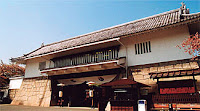OLD TOWNCULTUREdiverse
Golden PavilionatKinkaku-ji beforemujsimfall.the grandeurand beauty ofthe landscapebuildingamazevisitors
Behinda row ofbeautifultemples, differentpreoccupationresidinginKyoto, byTeguhWicaksono, executivesummarybydarmansjah
Onceagainon Kyoto. However, this time I do notwant tostoryabout thetemple. So, is there anything interestinghere? Iwould answeran emphaticyes. Try usonceagaincarefully. Apparently, notonly theincandescentbeautyshines onhistoric places. Kyotopulseis flowinginvariousexcitingactivities. Youdare totry it?
ToriigateheadingFushimi Inari Shrine, one of the memoirsofa geishamoviefilming
Different sensationscan beharvestedfromthe mealby the riveror commonlynamedKawayuka. Try tocome to thebanks of theKamoandlulled bythe cool airthat surrounds theareaalongthe river. While enjoying thebeautifullandscapesurroundingmountainousareaKyoya,youcan orderkyo-ryori(Kyoto classicmenu) orotherstyles ofculinarytreats.
When tiredwithformaland rigidatmosphere, browse theculinaryeuphoriain theKyotoNishikiMarket. Residentscall it"The Kitchen ofKyoto", and it tooka short timeto proveistialhit. Imagineriuhnyacomplexfood throughout the390m-from ShijoStreetandculminateinTakarukaStreet. On the road5mwide, there are morethan 100food vendors. ColorfulJapanese culinarylined up, rangingfromsmallsnacks, candy, dry food, snacks, fresh seafood, sushi, and so forth. Almost allfoods thatarein this marketisrelativelyfreshlocalproduction.
NishikiMarketis nota youngagethat originated fromthe Edo periodinthe 16th century. Here,the firstfish marketthere since1311.Until now, NishikiMarketstill getthe prestigeas the centerof Japanese food(did you know? Japanis knownas one of thesafestcountryin theworld. At nocases oflooting) inKyoto. But ifyour curiositycontinuestheprocess of makingdelicious menus, do not worry, youcan followHaruCooking Class-for directcookingin her kitchen. His house islocated notfar fromthe Kamo River. There youcan takea selection ofcookingclasses, as well as shareknowledgedirectly withthe participants.
Each classrunsfor approximately threehours, with a choice ofschedulesstartingeleven, twelve andthree o'clockandfour o'clock. In short, youareable toreact with theingredientsin the kitchen. If you are avegetarian, do not worry.HaruCooking Classalsooffervegetarianclasses.
twowomen infullmakeupgeisha
Afterchattingwith vibrant Japan culinary, it helps you calm downbyKyoto-style meditationcalledZazen. Thismeditationmethodis one of thebestalternative. Focusworldlydiversionthroughappreciation ofconsciencealaZazen, is the right choiceto fillspare timein theKyotoarea. Meditationrestoredby the philosophy ofZenBuddhismcanbe encountered insometemples, like theshrinesTaizou-in, Nanzen-in Temple, andTempleDaisen-in.
Accompanied bysoothingsilence, you are required tositcross-legged. You will be askedto drawabreathhara(center of gravity) witheyesslowly closed. This activityis one ofthe knightssamuraicraze.
Youare interested inlookinglike amightysamurai? VisitShuKatsuyama, located near theHigashiyamaStation. This storeis alsolocated notfarfrom theGionarea. Onlycosts12,000 yen, you'll looklikea samurai. Not only that,you alsocanbe abeautifulgeisha.
One placeto putema(prayer inscribedwood) at the TempleShimogamo
Another option, Kyoto Studio Park. Here are the locations for the shooting samurai-themed films, such as Yoshihara (the old town), the residence of Zenigata Heijiand other fun locations that exist in the Edo era. While dressed as asamurai, in this park you can also learn the history of Japanese cinema After that, you try to drop by The Cotume Museum, where you can meet with dolls dressed in various costumes exciting. For the people of Japan (did you know? Color white and silver was the favorite color of the vehicle in Japan. Different colors that dominate on the highway), the clothes have an important role in the movement of civilization. By visiting this place, you will understand how important costumes for the Japanese civilization.
When bored with location-that's all, flown Kyoto InternationalManga Museum. Mangais the term used to refer to Japanese comics. You definitely know doraemonlegendary figure, who once ruled the tv screen era of the 90s. Contained in the museum collection is not playing full. Even to this collection are not released in the market. Until the year 2011, there were 300,000 pieces mangacollection that originated from the Meiji era, 1868-1912. Explore the stories presented in the mangais also a good time to attempt a step further to interpret Japanese culture.





